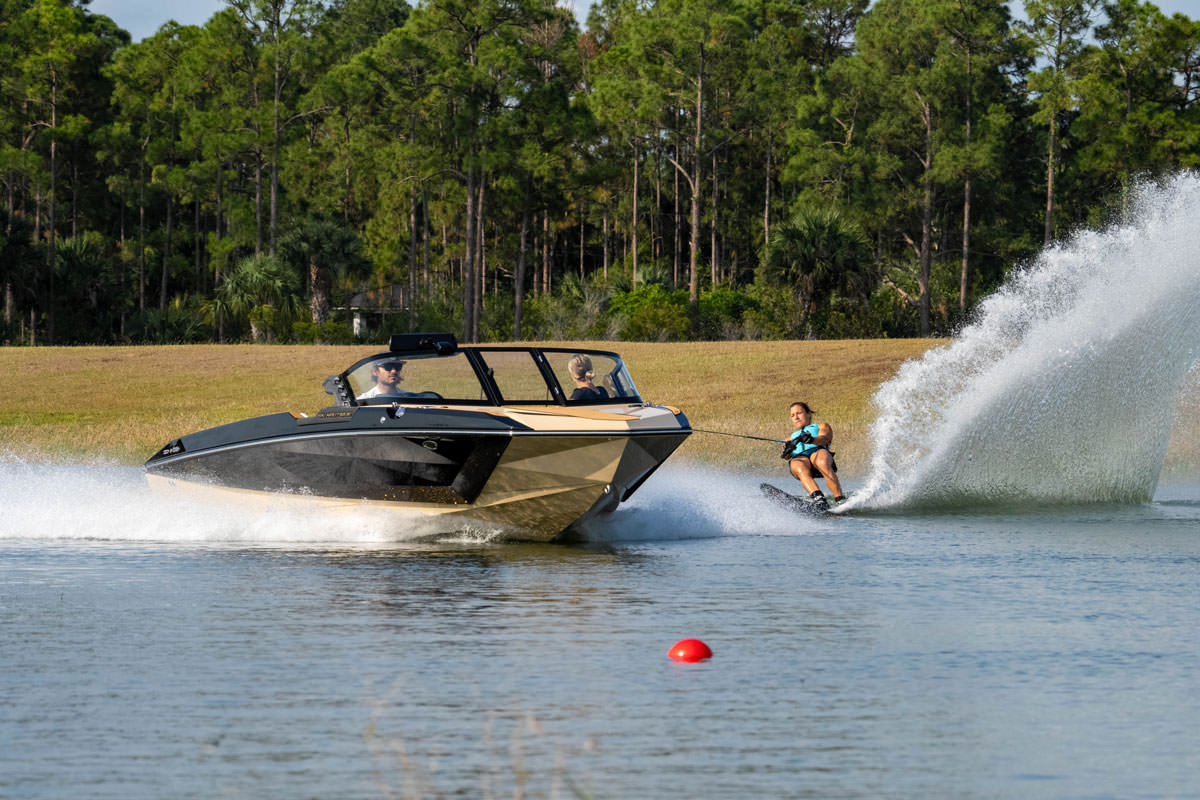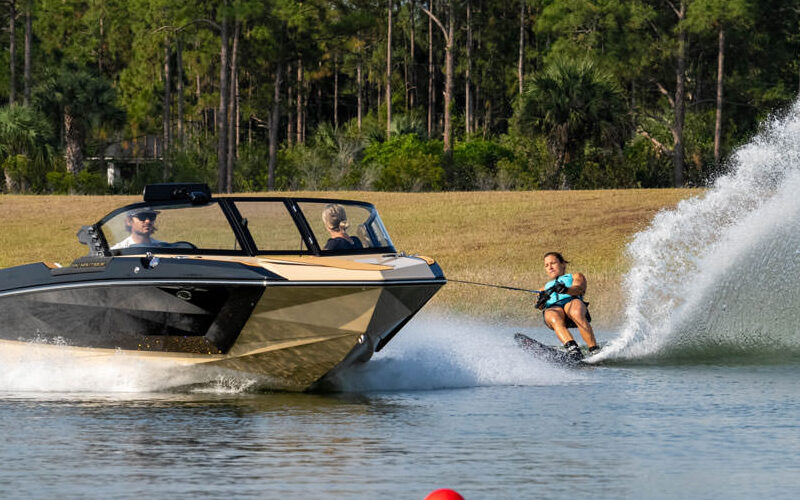A house divided: Nautique splits from the Waterski Pro Tour

Image: Nautique Boats
By Jack Burden
On a flawless summer morning, with water so flat it blurs the line between lake and sky, some of the world’s best slalom skiers wait their turn. They stretch, limber up, and ready themselves to launch down a course they know as intimately as their own signatures. The cameras roll. The engine’s roar cuts clean through the still air. From a distance, professional water skiing appears unshaken.
But beneath the polish, the sport stands once again on uncertain footing.
Fractured tours, softening prize purses, splintered sponsorships—and a question as old as the slalom course itself: who, exactly, is steering water skiing’s future?
This winter, as tournament schedules for another pro season locked into place, Nautique—the boat manufacturer as synonymous with waterskiing as Wilson is with tennis—quietly severed its final ties with the Waterski Pro Tour for 2025. On paper, it was a footnote. In practice, it was an earthquake.
This is the equivalent of Wimbledon quietly pulling out of the ATP Tour. Or if Augusta told the PGA: We’re good on our own this year, thanks.
Since its inception in 2021, the Pro Tour has been professional skiing’s most unifying force. Born out of pandemic-era recalibration, it bundled previously disconnected events into a coherent narrative, raising prize purses and driving a resurgence of fan interest. It created a season-long arc, elevating once-forgotten stops into destination tournaments. And for a few glorious seasons, the fractured sport of competitive skiing looked, briefly, like a professional tour again.
Nautique’s quiet exit cracks that illusion.
The writing, truthfully, has been on the wall for some time. Nautique is the primary sponsor of water skiing’s two longest-running and highest-paying events—the Moomba Masters and the U.S. Masters—both widely regarded as the sport’s equivalent of Majors. Nautique also serves as the primary organizer of the latter tournament. After its inclusion in the Pro Tour’s inaugural season in 2021, Nautique pulled the Masters out of the Tour. Then, when Moomba returned post-COVID in 2022, they too declined to participate.
A third blow came when the Botaski ProAm, a newer but increasingly important event, stepped away in 2023 after a single season of Pro Tour involvement. Another Nautique-sponsored event, Botaski’s withdrawal reinforced a trend.
Now in 2025, after four seasons as a fixture on the Pro Tour, the California ProAm will join the ranks of the two majors and Botaski on the sidelines. And just like that, the longest-running event on the Pro Tour is relegated to a sideshow—no longer relevant to any season-long narrative, unless one considers qualifying for the U.S. Masters to be the be-all and end-all of the water ski season.
Their reasoning? Officially muted. Representatives from Nautique Boats declined requests for an interview for this article.
It’s difficult—even when granting Nautique every benefit of the doubt—to formulate a coherent rationale for their aversion to the Pro Tour. Let’s be clear: it costs nothing for an event to be included on the Waterski Pro Tour. The perks are numerous—pre- and post-event marketing, social media exposure, highlight packages, and, most importantly, inclusion in an absorbing season-long narrative that gives any result the potential for broader ramifications.
Sure, there’s a reasonable argument for the majors to stay independent. They have the history, they have the brand. Arguably, the Masters’ decision to remain separate from the fledgling Coors Light Water Ski Tour in the 1980s saved it from the fate of other legacy tournaments like the California International Cup and the Tournament of Champions—both subsumed into the Tour brand and ultimately victims of the organization’s financial woes.
But the Waterski Pro Tour is just that: a brand name. It doesn’t take over existing tournaments. It supports them. It adds value. It’s hard to see how a tournament like the Botaski ProAm—begun as a small, men’s-only slalom event in 2018 and since expanded to include women and, more recently, tricks—has a brand strong enough to stand entirely apart. Surely the season-long narrative and visibility the Pro Tour brings is a value-add, not a liability.
The closest thing to a justification is a vision, hinted at publicly by Nautique insider Matt Rini during last year’s California ProAm: the idea of a Nautique-backed international circuit.
“Nautique is all about three-event—building a three-event boat,” he said. “The goal is to have four [tournaments], each featuring all three events, in a season. There’s no jump at Botaski, but they want to add it there. And they want tricks here [in California]. That would be amazing.”
That vision has been echoed before by Brian Sullivan, Nautique’s VP of Marketing, who once described the company’s ambition as “wanting to keep doing bigger and better events, to keep growing the sport—that’s one of our main goals.”
But even that ambition raises questions—chief among them, whether a parallel circuit run by a single manufacturer can truly grow the sport, or simply divide it further.
Nautique’s recent maneuvers, however, haven’t occurred in a vacuum. Taken alongside a string of recent controversies, they appear less like isolated strategic pivots and more like part of a broader pattern: control, consolidation, and increasingly contentious relations with athletes.
In recent years, the company has faced criticism for its rigid gatekeeping of the Masters — from Byzantine qualification procedures to the banning of a world champion for alleged unsportsmanlike conduct — as well as the contentious dismissals of top athletes like Jonathan Travers, Jacinta Carroll, and Patricio Font, raising concerns about its approach to athlete management.
Seen in that light, Nautique’s retreat from the Pro Tour looks less like a routine reshuffle and more like a tightening grip on the sport’s levers of power.
If so, they are not the first to try.
Competing pro tours have been attempted before in water skiing. Rarely with much success. In 1987, the American Water Ski Association launched the short-lived U.S. Grand Prix of Water Skiing to compete with the Coors Light Water Ski Tour. Then again, more dramatically, in 1990, Camille Duvall and a cadre of frustrated skiers attempted a coup. They launched an upstart circuit promising more prize money, athlete control, and safer skiing conditions.
For one turbulent season, skiing had two competing tours: the rebel PAWS circuit and the establishment Michelob Dry Tour. Sherri Slone famously won two pro jump titles on the same day.
The experiment imploded. Both tours crumbled under legal battles, sponsor fatigue, and logistical overload. By 1991, PAWS was gone. The old tour limped along, wounded but intact. The sport never fully recovered its eighties-era swagger.
Today, no one has openly declared “war” like Duvall once did. But Nautique’s move—alongside an already splintered calendar featuring the WWS Overall Tour and standalone events—feels eerily like history tightening its rope again.
On paper, these should be boom times. Each of the past three seasons has brought the highest prize purses in over 15 years. The gender pay gap has shrunk dramatically, from 60 cents on the dollar to near parity. The Waterski Broadcasting Company streams nearly every pro event, in crisp HD, for free. Fans can sit in their living rooms and watch the world’s best almost every weekend.
But peel back the webcast polish and cracks show.
The Swiss Pro Slalom—the sport’s most-watched webcast annually—has just been demoted from the Pro Tour after failing to secure adequate sponsorship. Jumping, once the marquee discipline of water skiing, has seen prize money slashed by more than half in the last decade. Even trick skiing, despite a recent resurgence on the water, still lags far behind its 2000s heyday in financial support.
For the first time since 2020, when the global pandemic shuttered nearly all events, professional prize purses are forecast to decline in 2025.
Even Nate Smith, the most dominant slalom skier of his generation, has quietly taken on a “real job” in recent years to stay afloat. Coaching gigs and benevolent parents remain as crucial as gate setups at 41 off.
It begs the question: can the sport really sustain another professional circuit? Can a niche sport like water skiing afford this level of fragmentation?
The cameras are still rolling. The rope still hangs off the pylon. The skiers will ski. And for now, the sport holds together—if just barely.
But history in this sport doesn’t repeat itself quietly. Every time water skiing has splintered before, it’s taken years to recover. Some fractures have never fully healed.
Now, both sides risk losing something vital.
Nautique’s events—the crown jewels of professional skiing—draw their power from prestige, history, and the feeling that they are the center of the sport’s universe. Walling them off too far from the broader narrative risks dulling their shine, turning majors into outliers.
At the same time, the Pro Tour loses critical legitimacy without the weight of the sport’s longest-standing events on its calendar. Fans, athletes, and sponsors are left navigating a fragmented landscape—unsure which path truly leads to the sport’s future.
The truth is, no one wins a fractured season.
Not Nautique. Not the Tour. Not the athletes. Not the fans.
If the sport is to move forward, it needs everyone—manufacturers, organizers, and athletes—rowing in the same direction again.
There’s still time to course-correct.
Hopefully, someone picks up the rope.

